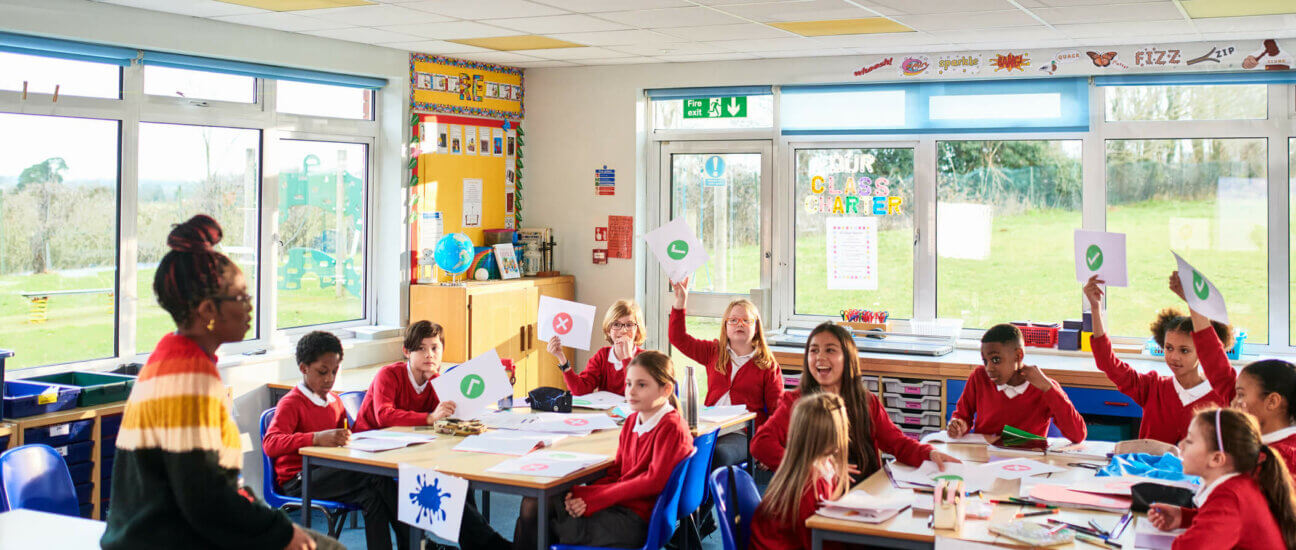Published on December 5th, 2023
How To Improve Behaviour In Schools: A Teacher’s Guide
9 minute read

As a teacher, one of the most critical aspects of your role is improving and managing behaviour in schools. Poor behaviour can be a significant cause of stress for teachers and have a lasting impact on students. However, by adopting simple approaches as part of your regular routine, you can provide an interactive and enjoyable experience in the classroom for your students and yourself.
In this guide, we provide you with practical classroom management strategies and recommendations for improving behaviour in schools, resulting in better student engagement and outcomes.
Why do some students misbehave in school?
Pupil behaviour has multiple influences, and it’s not always a simple issue to address. However, understanding the root causes of challenging behaviour is essential for improving it. Some common factors contributing to misbehaviour include:
- Social and emotional factors: Students may have personal issues, such as anxiety, family problems, or peer conflicts, which can lead to misbehaviour.
- Learning difficulties: Students with learning difficulties may become frustrated, leading to disruptive behaviour as a way to cope.
- Boredom: A lack of engagement with the curriculum or teaching methods can cause students to lose interest and misbehave.
- Peer pressure: Students can be influenced by their peers to engage in disruptive behaviour.
- Need for attention: Some students act out to seek attention, even if it’s negative.
Why is it important to promote good school behaviour?
Promoting good behaviour is of the utmost importance as it lays the foundation for a positive and nurturing learning environment. Beyond the immediate benefits, such as enhanced learning and reduced stress for students and teachers, it paves the way for developing crucial life skills.
The benefits of good classroom behaviour for students
- Enhanced learning: When the classroom environment is conducive to good behaviour, students can focus on learning, leading to improved attainment outcomes.
- Emotional well-being: A positive and respectful atmosphere reduces stress and anxiety, enhancing students’ emotional well-being.
- Fosters good habits: Positive behaviours instil vital life skills, like self-discipline and conflict resolution.
The benefits of good classroom behaviour for teachers
- Reduced stress: Effective classroom management strategies and good behaviour policies reduce stress for teachers.
- Efficient teaching: Teachers can spend more time teaching and less time dealing with misbehaviour.
- Job satisfaction: A well-behaved classroom leads to greater job satisfaction for teachers.
Ways to improve classroom behaviour in schools
To reap these benefits, it’s crucial to establish positive behavioural practices in the classroom. Whilst teaching students how to behave might sound like an impossible feat, there are approaches that you can incorporate into your lessons to encourage better behaviour.
Here are seven recommendations for obtaining focus in your classroom:
1. Empower your classrooms
It’s essential to focus on teaching and encouraging positive learning behaviours in addition to managing misbehaviour. This approach helps create a more inclusive and effective learning environment.
The Education Endowment Foundation (EEF) guidance report suggests several evidence-based classroom management strategies to support good behaviour. These include setting clear expectations, rewarding positive behaviour, and providing timely and specific feedback.
2. Use targeted approaches
Remember, every student is unique. Develop targeted approaches to meet the needs of individual pupils in your class. Consider their unique circumstances and learning styles when crafting your classroom management strategies and provide a personalised approach.
The majority of students in your lessons want to learn, so it’s crucial to know and understand the individuals in your school, making them feel seen and addressing their needs with utmost importance.
3. Embrace interactive whiteboard technology
Use interactive whiteboards to make lessons more engaging and interactive, helping to capture students’ attention and reducing the likelihood of misbehaviour. The EEF guidance report suggests that technology can be a valuable tool in improving behaviour in the classroom.
Find ways to engage your classroom with a free demo of our ActivPanel – either virtual, remote, or on-site.
4. Consistency is key
By maintaining consistency in your classroom strategies, you will surely see an improvement in pupils. School leaders should also support these strategies at a whole school level to ensure coherence and alignment.
5. Use classroom management strategies
Regularly reflect on your classroom management strategies and make necessary adjustments. Flexibility and adaptability are essential in addressing changing behaviour patterns.
6. Teach learning behaviours alongside managing misbehaviour
Incorporate the teaching of behaviour into your daily routine. Ensure students know what is expected of them in the classroom. Share these expectations, reinforce them consistently, and offer guidance on how to meet them.
7. Engage in professional development
As a teacher, it is important to seek opportunities for continuous professional development. Attend workshops, conferences, or training sessions on effective classroom management and behaviour improvement. Learning from experts and sharing experiences with fellow educators can provide valuable insights and fresh ideas.
Key takeaways for improving behaviour in schools
Supporting good classroom behaviour in schools is a multifaceted challenge, but it’s achievable by using evidence-based strategies, personalising your approach, and incorporating technology to engage students.
Interactive displays, like the ActivPanel display, are invaluable for effectively engaging and motivating students to participate actively.
To help you ensure consistently high levels of engagement in lessons, regardless of the subject, our blog is full of advice. From how to engage shy and quiet students to measuring engagement at university, we have tips for helping every age group achieve.
FAQs about improving behaviour in schools
What is the EEF guidance report?
The Education Endowment Foundation (EEF) guidance report is a comprehensive resource that provides evidence-based recommendations for improving teaching and learning in the UK. It offers guidance on effective classroom management strategies and other educational practices to support good behaviour and enhance student outcomes.
How can teachers reduce the need for more intensive support?
Teachers can reduce the need for more intensive support by proactively addressing behavioural issues through effective classroom management strategies. This includes creating a classroom environment with clear expectations, consistent routines, and positive reinforcement for good behaviour.
How can teachers encourage pupils to exhibit good classroom behaviour?
Encouraging good classroom behaviour involves creating a positive and engaging learning environment. Clear expectations, positive reinforcement, and interactive teaching methods are effective ways to motivate students to exhibit good behaviour.
What are the six behavioural strategies?
When confronted with uncomfortable and challenging behaviour, it’s important to remain calm and keep your composure. Below are the six reliable behavioural strategies for maintaining professionalism when confronted with challenging situations:
- Self-awareness: Be mindful of your initial reaction.
- Emotional detachment: Maintain a rational perspective.
- Active listening: Stay attentive to the situation.
- Positive self-talk: Use constructive inner dialogue.
- Boundaries: Recognise your personal limits.
- Reflect: Conduct a post-situation debrief.




